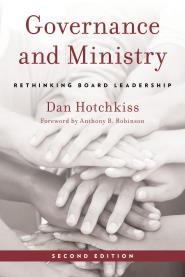
Is your board members’ time well spent? A twelve-member board that meets for two hours once a month consumes 288 person hours. That’s seven full work weeks, not counting preparation time. Poll your retiring board members, if you dare. If your board is like many others, you’ll tap into a deeper well of dissatisfaction than most leaders suspect.
What can be done? A lot, fortunately! Most congregations follow patterns of board life that are out of date—to put it kindly—and long overdue to be reformed. In Governance and Ministry, I spell out a road map for comprehensive governance change.
But not every congregation’s board is ready for a revolution. Luckily, you can do a lot while you are waiting. (Warning: Boards in conflict should get help managing the conflict before making changes to their rules or practices. In conflict, people tend to seize on any change proposal as a fresh battleground.) Here’s a list of steps that should be possible for almost any board.
1. Ban oral reports.
Okay, I know this feels like a stretch. Lots of people feel entitled to airtime at your board meetings, and it will be hard to break them of that expectation. But a board listening to a report is passive. After a year of listening to reports, board members feel like victims more than leaders.
Instead of letting people drone on about how busy they have been, try framing all of your board’s agenda items in the active voice (the board doing something) rather than the passive (the board listening to initiatives from others).
A board does need to receive reports so it can monitor the work of others. But it doesn’t need to let reports take any of its scarce in-person meeting time. Smart boards require all reports to be prepared in writing, in time to be collected and sent out well in advance of the meeting. Set a limit of one page or 300 words. The punishment for late reports is that you have to wait a month—not that you get to give your report in person after all!
And yes, Pastor, I mean you, too. You, too, Madame Treasurer. Anything about your work that really needs to come up during a board meeting can be recast as board business. Information can be given as a briefing paper in support of the board’s agenda.
Try it. Habitual reporters may complain, but quieter board members will be grateful.
2. Use a consent agenda.
Sometimes boards must act on things that are not worth the time it takes to move and second, much less debate and vote on them. For instance, any time an organization opens an account, the bank requires the board to pass a resolution. I’ve seen those resolutions read, moved, seconded, discussed, and joked about before they were adopted by a vote that might as well have been predestined at the time of the Creation.
Some denominations require local boards to vote on the admission of each new member. That is real business for a board that seriously examines applicants and frequently denies them membership—but for mainline Presbyterians? Seriously? My favorite pointless action item—whose absurdity I hope needs no explaining—is the vote to “dismiss” members who are moving out of town.
A better way to deal with such required, no-brainer actions is to divide each meeting’s agenda into two parts. First comes the consent agenda, which contains approval of last month’s minutes and all other items that require official action but do not need to be discussed. Next comes the discussion agenda. Ideally this consists of one or two big, juicy, interesting, future-oriented topics, followed by such smaller matters the board needs to decide. The decision about what items to put on which agenda is made by the person the board authorizes to create the agenda—usually the board chair or a small committee that includes the board chair.
Make no mistake—setting the agenda is an exercise of power! This is true at any meeting. The consent agenda process only makes that exercise of power more explicit and transparent and accountable.
At the beginning of the business portion of the board meeting, the board chair says, “You have all received the board packet with the consent agenda. Does any member wish to move an item from the consent agenda to the discussion agenda?”
If any member requests it, an item is moved. (If possible, the member should give notice to the board chair in advance.) The chair then says, “We are ready to approve the consent agenda. Hearing no objection [the chair pauses briefly], all items on the consent agenda are adopted.” Note that there is never a discussion about whether to move an item to the discussion agenda.
Try it! You’ll be surprised how much the use of a consent agenda streamlines and enlivens your board meetings.
3. Start a board policy book.
Some board actions create policy, and others don’t. A policy is a lasting action meant to control many decisions over time. Policies impose consistency on decision-making, so people come to trust the principles behind decisions even when they don’t always get what they prefer.
Ideally, a policy also makes it possible for most decisions to be made away from the board table. By delegating power to make decisions under the guidance of a policy, the board saves itself a lot of tedious work and speeds up routine decision making a great deal.
You might start by collecting your existing policies. Appoint a committee to sift through your board minutes and the various random documents it has created over the years. But don’t hold your breath. Such efforts take a long time, and you do not need to wait for them to be compete before you start collecting your new a policies into a book.
Starting today, each time your board takes a vote, decide whether it has voted on policy or not. Either way, the action is recorded in the minutes. A policy is also written in the policy book, along with the date it was adopted. As policies accumulate, you’ll want to organize the book with sections and subsections. But the main thing is: start now.
Improving the effectiveness of boards and making life more fun for board members is an endless job. No reform is permanent, no “governance model” perfect. Comprehensive governance reform takes several years and lots of work. But any board can do these three things. If you want to read more about them, you can find details in Governance and Ministry, especially in chapter 6, “Productive Board Meetings.” Productive meetings, happily, tend to be fun and satisfying meetings also!
[box] Dan Hotchkiss consults with congregations and other mission-driven groups from his home near Boston. He is the author of the best-selling Alban book Governance and Ministry: Rethinking Board Leadership, which has helped hundreds of churches, synagogues, and non-profit organizations to streamline their structure and become more mission-focused and effective.
Dan Hotchkiss consults with congregations and other mission-driven groups from his home near Boston. He is the author of the best-selling Alban book Governance and Ministry: Rethinking Board Leadership, which has helped hundreds of churches, synagogues, and non-profit organizations to streamline their structure and become more mission-focused and effective.
[/box]
